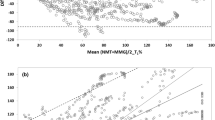Abstract
The variability or inaccuracy of acceleromyographic measurements could interfere with the interpretation of the train-of-four (TOF) ratio during neuromuscular block (NMB) recovery. This study evaluated the precision and performance of the Philips Intellivue NMT module (NMT) before (part 1) and after (part 2) several technical upgrades (i.e., firmware upgrade, new cable, and hand adapter) that were recently available. Two cohorts of 30 patients who were scheduled to undergo rhino/septoplasty under general anesthesia were included in the study. TOF ratios were recorded simultaneously every 15 s on both hands with the NMT and a TOF-Watch SX installed inside a SL TOF-Tube (TWX). Before rocuronium was administered and once final responses were stabilized, the average of the four successive measurements that determined the baselines and repeatability coefficients were compared using a z test. Simultaneous measurements were recorded at different NMB stages: onset, depth of NMB after intubation, when TWX recovered TOF count 2, TOF ratios 0.5 and 0.9, and when NMT recovered TOF ratio 0.9. The results were compared using a Student t test; p < 0.05 was considered significant. The NMT repeatability coefficients obtained in part 1 were significantly higher than with the TWX, they were significantly lower in part 2. Initially, the NMT significantly overestimated NMB recovery at every stage. Conversely, in the second part of the study, no difference reached statistical significance. With the recent upgrades and the new hand adapter, the NMT provided similar results compared with the TWX, Their implementation should be recommended in clinical practice.
Similar content being viewed by others
References
Fuchs-Buder T, Claudius C, Skovgaard LT, Eriksson LI, Mirakhur RK, Viby-Mogensen J. Good clinical research practice in pharmacodynamic studies of neuromuscular blocking agents II: the Stockholm revision. Acta Anaesthesiol Scand. 2007;51:789–808.
Naguib M, Brull SJ, Kopman AF, et al. Consensus statement on perioperative use of neuromuscular monitoring. Anesth Analg. 2018;127:71–80.
Murphy GS, Brull SJ. Residual neuromuscular block: lessons unlearned. Part II: methods to reduce the risk of residual weakness. Anesth Analg. 2010;111:129–40.
Plaud B, Debaene B, Donati F, Marty J. Residual paralysis after emergence from anaesthesia. Anesthesiology. 2010;112:1013–22.
Eikermann M, Vogt FM, Herbstreit F, et al. The predisposition to inspiratory upper airway collapse during partial neuromuscular block. Am J Respir Crit Med. 2007;175:9–15.
Murphy GS, Szokol JW, Marymont JH, et al. Intraoperative acceleromyographic monitoring reduces the risk of residual neuromuscular blockade and adverse respiratory events in the postanesthesia care unit. Anesthesiology. 2008;109:389–99.
Murphy GS, Szokol JW, Avram MJ, et al. Postoperative residual neuromuscular blockade is associated with impaired clinical recovery. Anesth Analg. 2013;117:133–41.
Viby-Mogensen J, Jensen E, Werner M, Nielsen HK. Measurement of acceleration: a new method of monitoring neuromuscular function. Acta Anaesthesiol Scand. 1988;32:45–8.
Claudius C, Viby-Mogensen J. Acceleromyography for use in scientific and clinical practice. A systematic review of the evidence. Anesthesiology. 2008;108:1117–40.
Viby-Mogensen J. Neuromuscular monitoring. Curr Opin Anesthesiol. 2001;14:655–9.
Schreiber JU, Mucha E, Fuchs-Buder T. Acceleromyography to assess neuromuscular recovery: is calibration before measurement mandatory? Acta Anaesthesiol Scand. 2011;55:328–31.
Suzuki T, Fukano N, Kitajima O, Saeki S, Ogawa S. Normalization of acceleromyographic train-of-four ratio by baseline value for detecting residual neuromuscular block. Br J Anaesth. 2006;96:44–7.
Stouffs A, Ibsen A, Jamart J, Dubois V, Dubois PE. Philips Intellivue NMT module: variability of initial measurements. J Clin Monit Comput. 2018;32:965–6.
Dubois PE, De Bel M, Jamart J, et al. Performance of acceleromyography with a short and light TOF-tube compared with mechanomyography. A clinical comparison. Eur J Anaesthesiol. 2014;31:404–10.
Faul F, Erdfelder E, Lang AG, Buchner A. G*Power 3: a flexible statistical power analysis program for the social, behavioral, and biomedical sciences. Behav Res Methods. 2007;39:175–91.
Mencke T, Echternach M, Kleinschmidt S, et al. Laryngeal morbidity and quality of tracheal intubation: a randomized controlled trial. Anesthesiology. 2003;98:1049–56.
Bruintjes MH, van Helden EV, Braat AE, et al. Deep NMB to optimize surgical space conditions during laparoscopic surgery: a systematic review and meta-analysis. Br J Anaesth. 2017;118:834–42.
Claudius C, Skovgaard LT, Viby-Mogensen J. Acceleromyography and mechanomyography for establishing potency of neuromuscular blocking agents: a randomized-controlled trial. Acta Anaesthesiol Scand. 2009;53:449–54.
Claudius C. Calibration of the neuromuscular monitoring: is it necessary? Can J Anesth. 2016;63:354–5.
Kopman AF, Chin W, Cyriac J. Acceleromyography vs. electromyography: an ipsilateral comparison of the indirectly evoked neuromuscular response to train-of-four stimulation. Acta Anaesthesiol Scand. 2005;49:316–22.
Brull SJ, Silverman DS. Real time versus slow motion train-of-four monitoring: a theory to explain the inaccuracy of visual assessment. Anesth Analg. 1995;80:548–51.
Kopman AF. Measurement and monitoring of neuromuscular blockade. Curr Opin Anaesthesiol. 2002;15:415–20.
Claudius C, Skovgaard LT, Viby-Mogensen J. Is the performance of acceleromyography improved with preload and normalization ? A comparison with mechanomyography. Anesthesiology. 2009;110:1261–70.
Capron F, Alla F, Hottier C, Meistelman C, Fuchs-Buder T. Can acceleromyography detect low levels of residual paralysis? A probability approach to detect a mechanomyographic train-of-four ratio of 0.9. Anesthesiology. 2004;100:1119–24.
Claudius C, Skovgaard LT, Viby-Mogensen J. Arm-to-arm variation when evaluating neuromuscular Block: an analysis of the precision and the bias and agreement between arms when using mechanomyography or acceleromyography. Br J Anaesth. 2010;105:310–7.
Author information
Authors and Affiliations
Corresponding author
Ethics declarations
Conflict of interest
Dubois PE perceived grants from Merck Belgium for publications in the field of neuromuscular transmission monitoring development and honorarium for lectures but, as all co-authors, has no conflict of interest with the present study.
Additional information
Publisher’s Note
Springer Nature remains neutral with regard to jurisdictional claims in published maps and institutional affiliations.
Rights and permissions
About this article
Cite this article
Dubois, V., Fostier, G., Dutrieux, M. et al. Philips Intellivue NMT module: precision and performance improvements to meet the clinical requirements of neuromuscular block management. J Clin Monit Comput 34, 111–116 (2020). https://doi.org/10.1007/s10877-019-00287-y
Received:
Accepted:
Published:
Issue Date:
DOI: https://doi.org/10.1007/s10877-019-00287-y




